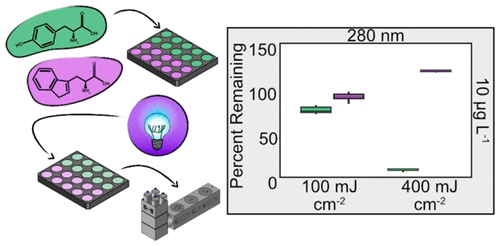当前位置:
X-MOL 学术
›
ACS ES&T Eng.
›
论文详情
Our official English website, www.x-mol.net, welcomes your
feedback! (Note: you will need to create a separate account there.)
Instrument Hacking: Repurposing and Recoding a Multiwell Instrument for Automated, High-Throughput Monochromatic UV Photooxidation of Organic Compounds
ACS ES&T Engineering ( IF 7.4 ) Pub Date : 2020-10-01 , DOI: 10.1021/acsestengg.0c00123 Sean A. MacIsaac 1 , Crystal L. Sweeney 1 , Graham A. Gagnon 1
ACS ES&T Engineering ( IF 7.4 ) Pub Date : 2020-10-01 , DOI: 10.1021/acsestengg.0c00123 Sean A. MacIsaac 1 , Crystal L. Sweeney 1 , Graham A. Gagnon 1
Affiliation

|
Bench-scale UV experiments are an inefficient and laborious process when using current flow-through and collimated beam technologies. Current technologies are also limited in their ability to customize the emitted wavelength of light. Existing monochromatic UV technologies such as UV–LEDs that are tunable to the full UV–C spectrum are not currently available. The objective of this study was to repurpose a commercially available automated water analysis tool (microplate reader) into a high-throughput, wavelength tunable, proof-of-concept UV-oxidation platform, allowing for significant time savings for bench-scale UV experiments. The light source was characterized via actinometry using potassium ferrioxalate, which was combined with fluence equations to control the amount of UV light delivered to microplate wells. Repurposing a microplate reader as an automated, proof-of-concept UV-oxidation platform through the creation of a novel software script resulted in the first reported demonstration of high-throughput bench-scale UV treatment of water samples with unique control over output wavelengths.
中文翻译:

仪器黑客:重新定义和编码用于自动化,高通量单色有机化合物紫外光氧化的多孔仪器
当使用电流流通和准直光束技术时,台式紫外线实验是一种低效且费力的过程。当前技术在定制光的发射波长的能力方面也受到限制。现有的单色UV技术(例如可调整至整个UV-C光谱的UV-LED)目前尚不可用。这项研究的目的是将市售的自动化水分析工具(酶标仪)重新用于高通量,波长可调,概念验证的UV氧化平台,从而为台式UV实验节省大量时间。使用亚铁酸钾通过光度法对光源进行了表征,并与通量方程式结合以控制传递至微孔板孔的紫外光量。
更新日期:2020-10-01
中文翻译:

仪器黑客:重新定义和编码用于自动化,高通量单色有机化合物紫外光氧化的多孔仪器
当使用电流流通和准直光束技术时,台式紫外线实验是一种低效且费力的过程。当前技术在定制光的发射波长的能力方面也受到限制。现有的单色UV技术(例如可调整至整个UV-C光谱的UV-LED)目前尚不可用。这项研究的目的是将市售的自动化水分析工具(酶标仪)重新用于高通量,波长可调,概念验证的UV氧化平台,从而为台式UV实验节省大量时间。使用亚铁酸钾通过光度法对光源进行了表征,并与通量方程式结合以控制传递至微孔板孔的紫外光量。











































 京公网安备 11010802027423号
京公网安备 11010802027423号